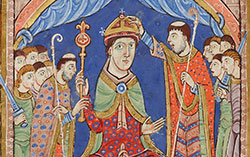
Miscellany on the life of St. Edmund (MS M.736).
19th-century olive-brown morocco, gold-tooled to a Renaissance design and lettered on upper cover: Vita Martyrium et Miracula Sancti Eadmundi Regis Angliae Codex M.S. Saec. XII.
Purchased by J.P. Morgan (1867-1943) in 1927.
100 leaves (1 column, 32 lines), bound : vellum, ill. ; 274 x 187 mm
Probably made at the Benedictine Abbey of Bury St. Edmunds, Suffolk; George Roche (16th-century signature on fol. 2); Walter Stonehouse (1597-1655; signature on fols. 2 and 5); Robert Parker (d. 1712), signed on fols. 1 and 5; Thomas Lister Parker (1779-1858); John Towneley (1731-1813; his sale, London, R.H. Evans, 8 June 1814, lot 904) to Booth; Sir George Osborne Page-Turner (1785-1848); his anonymous sale in London, Christie's, 17 March 1828, lot 173, bought by Booth; Payne & Foss (catalogue 1841, lot 1); sold to Robert Stayner Holford (1808-92), by descent to his eldest child; Sir George Lindsay Holford (1860-1926); purchased by J.P. Morgan (1867-1943) for the Pierpont Morgan Library from the Holford Estate in 1927.
Ms. miscellany on the life of St. Edmund; written and illuminated in the Abbey of Bury St. Edmunds, ca. 1130
Texts: Henry I, King of England, letter to Anselm, abbot of Bury St. Edmunds, forbidding him from going on a journey (fol. 2); Talebot, prior of Bury St. Edmunds, letter to Anselm, abbot of Bury St. Edmunds begging him to return from Normandy (fol. 2-3); records of pittances given to the monks by Anselm, abbot of Bury St. Edmunds (fol. 3-4); offices of the Catholic Church for St. Edmund (fol. 5-6); Miracula Sancti Edmuni regis et martiris (fol. 23-76); Passio Sancti Edmundi (fol. 77-86); offices of the Catholic Church for St. Edmund (fol. 87-100).
The Miracula Sancti edmundi regis et martiris has been attributed to Osbert of Clare, but it is based on an earlier compilation by Herman the Archdeacon--Cf. PML files.
Musical notation: the offices of St. Edmund contain 3-line staves in red ink with neumes.
Artist: the Alexis Master and his workshop.


One of the earliest illustrated biographies of an English saint, this lavish volume was a testimonial to patron saint and abbey alike. Most miniatures are based on the passion text of Abbo of Fleury (945-1004); the posthumous miracles depend on Osbert of Clare's text, composed for Anselm shortly before this manuscript was made. In this image, eight thieves are miraculously paralyzed when they attempt to break into Edmund's burial place. The miniatures are attributed to the Alexis Master, founder of the St. Albans school. Named after his St. Alexis cycle in the St. Albans Psalter, he skillfully combined Anglo-Saxon, Ottonian, and Byzantine influences to create England's earliest Romanesque style.